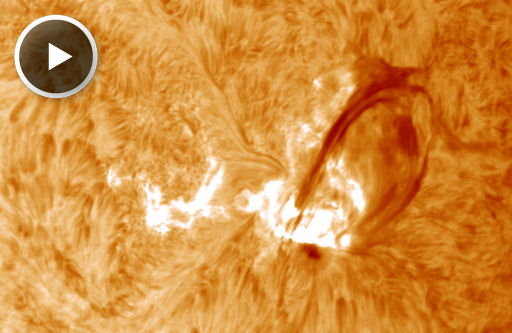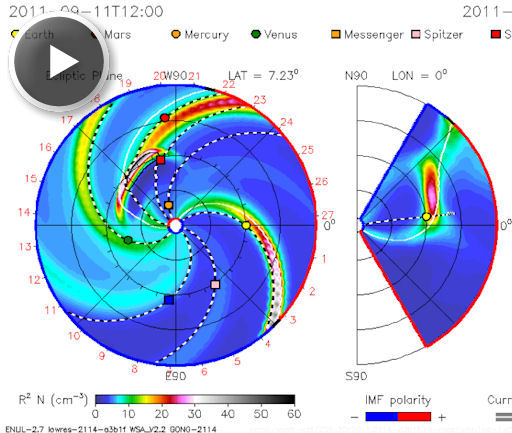Turn your cell phone into a field-tested satellite tracker. Works for Android and iPhone. | | |
GEOMAGNETIC STORM: A strong geomagnetic storm (Kp=7) is in progress following the impact of a CME around 1130 UT on Sept. 9th. This could be the first of several hits from a series of CMEs expected to reach Earth during the weekend. High-latitude sky watchers should be alert for auroras after nightfall. Aurora alerts: text, voice.
Update: Electrical ground currents caused by the storm have been detected in Norway.
ACTIVE SUNSPOT: Sunspot 1283 is producing flares so intense they are visible through solar telescopes in backyards 93 million miles away. Amateur astronomer Andy Devey photographed this one, and M6-class eruption, from Barnsley UK on Sept. 8th:

The magnetic canopy of sunspot 1283 has an unstable "beta-gamma-delta" configuration tthat harbors energy for more powerful eruptions. NOAA forecasters estimate a 75% chance of M-flares and a 25% chance of X-flares during the next 24 hours. Solar flare alerts: text, voice.
more images: from Bob Yoesle of Goldendale, Washington; from Sergio Castillo of Inglewood, California; from Monty Leventhal OAM of Sydney, Australia; from James Kevin Ty of Manila, Philippines; from Alcaria Rego of Almada, Portugal
MERCURY-DIRECTED CME: On Sept 8th around 2300 UT, the SOHO and STEREO spacecraft detected a significant CME emerging from the farside of the sun. Earth is not in the line of fire, but the planet Mercury is. Analysts at the Goddard Space Weather Lab estimate that the cloud will reach the innermost planet on Sept. 9th at 12:00 UT (plus minus 7 hours). Click to view a movie of their CME model:

NASA's MESSENGER spacecraft is in orbit around Mercury, so it will have a front row seat for the impact. Researchers are keen to learn how Mercury's magnetosphere responds to CMEs. In particular, they wonder if CMEs can overpower Mercury's magnetic field and sputter atoms right off the planet's surface. Thanks to the Goddard forecast, MESSENGER's controllers know the CME is coming, and they can prepare to observe the impact.
Interplanetary space weather forecasting is a new thing. It became possible in 2010-2011 when NASA and ESA spacecraft surrounded the sun. Working together, SOHO, the Solar Dynamics Observatory, STEREO-A and STEREO-B now have the entire star under surveillance. CMEs can be tracked no matter where they go, which means space weather isn't just for Earth anymore.
September 2011 Aurora Gallery
[previous Septembers: 2010, 2009, 2008, 2007, 2006, 2005, 2004]
Potentially Hazardous Asteroids (
PHAs) are space rocks larger than approximately 100m that can come closer to Earth than 0.05 AU. None of the known PHAs is on a collision course with our planet, although astronomers are finding
new ones all the time.
On September 9, 2011 there were 1244 potentially hazardous asteroids.
Notes: LD means "Lunar Distance." 1 LD = 384,401 km, the distance between Earth and the Moon. 1 LD also equals 0.00256 AU. MAG is the visual magnitude of the asteroid on the date of closest approach. | | The official U.S. government space weather bureau |
| | The first place to look for information about sundogs, pillars, rainbows and related phenomena. |
| | Researchers call it a "Hubble for the sun." SDO is the most advanced solar observatory ever. |
| | 3D views of the sun from NASA's Solar and Terrestrial Relations Observatory |
| | Realtime and archival images of the Sun from SOHO. |
| | from the NOAA Space Environment Center |
| | the underlying science of space weather |
| | for out-of-this-world printing and graphics |

